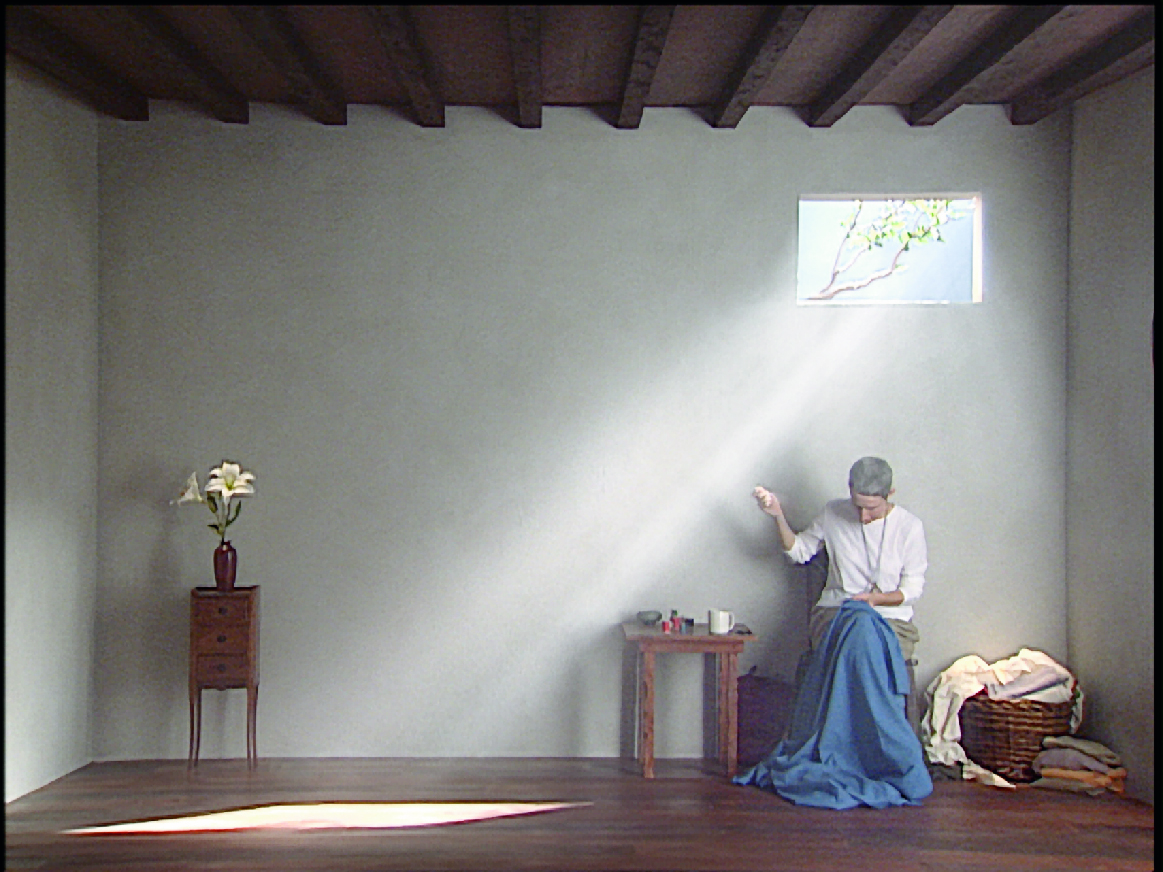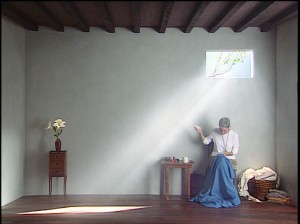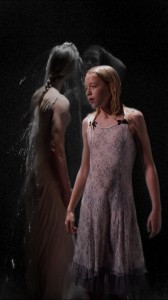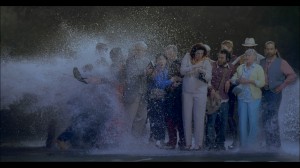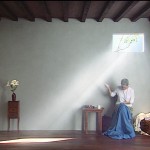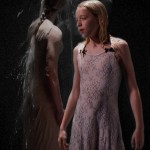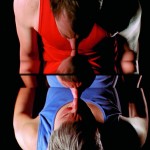by Carla St Louis
If you’re not an avid art viewer, interpreting Bill Viola’s exhibition, Liber Insularum can be daunting. Viola, a leading practioner of video art, draws from Eastern & Western spiritual traditions, and explores themes like reality, consciousness, unconsciousness, time, birth, and death. What differentiates him from other artists is his usage of plasma screens opposed to canvas in conveying his message. In alphabetical order, below is a rundown of the most moving pieces from his digital world-friendly work.
Ascension, 2000
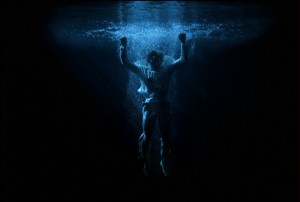 What’s it like to dive into the unknown? Short answer: Mind-numbingly scary. In this piece, the stillness of an underwater landscape is broken when a fully clothed man suddenly plunges into the water from above. Is his plunge a metaphor for our transition from childhood into adulthood? ‘Will the all-encompassing water consume him,’ you wonder? Or, will he manage to swim? Reeking of existential crisis, it is simultaneously frightening, haunting, and terrifying.
What’s it like to dive into the unknown? Short answer: Mind-numbingly scary. In this piece, the stillness of an underwater landscape is broken when a fully clothed man suddenly plunges into the water from above. Is his plunge a metaphor for our transition from childhood into adulthood? ‘Will the all-encompassing water consume him,’ you wonder? Or, will he manage to swim? Reeking of existential crisis, it is simultaneously frightening, haunting, and terrifying.
Ancestors, 2012
 Two individuals emerge out of a desert landscape, their images passing through shimmering heat. The blurry figures–one carrying a backpack while the other bag less—are recognizable as men because of their built, walk for what seems like an eternity.
Two individuals emerge out of a desert landscape, their images passing through shimmering heat. The blurry figures–one carrying a backpack while the other bag less—are recognizable as men because of their built, walk for what seems like an eternity.
They walk without ever stopping. For a split second, I think, “They seem to be getting somewhere” but for some reason they remain trapped in the distance. Is this symbolic of the journey of life: Wandering into the unknown?
Catherine’s Room, 2001
Human beings are ritualistic by nature. Case in point, this piece that features a solitary woman repeating a series of rituals throughout a single day, as depicted across five flat panel screens arranged in a horizontal row. The woman, Catherine is consumed by her rituals. They are simple to say the least: she writes at her desk, washes her face, sews clothing, lights her candle, and other performs other mundane acts. As she tires herself over her chores, sunlight shines through her windows, and it is at that moment you ask, ‘Where are the people in her life?’ Is she married? Does she have children? Where are her friends & family? Is she a recluse or an outcast? She appears content but her body language conveys loneliness. Catherine’s disconnect from the outside world demonstrates how easy and dangerous it’s become to create your own reality.
Observance, 2002
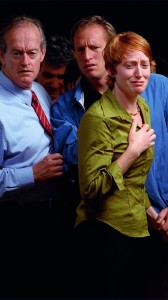 A case study in judgment, this piece features a steady stream of people moving through the frame, their faces overcome with emotion as their gaze fixes on an object in the distance.
A case study in judgment, this piece features a steady stream of people moving through the frame, their faces overcome with emotion as their gaze fixes on an object in the distance.
One by one, each person took turn watching and gave his or her negative reaction. What or whom has caused these people to react so negatively? Their reactions were the highlights: disgust, tears, puzzlement, and somewhere I imagined I saw empathy but even that quickly turned into revulsion. But as all these people shared their communal disdain I wondered, “Why weren’t they compelled to intervene about whatever was causing them such affliction?”
Surrender, 2001
A lot can be said about romantic relationships, namely you compromise some of your independence to the union. Clearly, Viola agrees with this sentiment as is the faith of a male and female image that appears separately on two screen panels performing synchronized prostrations. Their faces are unrecognizable, seemingly manipulated like drops in a puddle. For all their synchrony something grotesque happens: they merge into one puddle of nothingness. Thus, it is representation of every collegiate relationship.
Three Women, 2008
Who are these women? Three ghostly figures of various ages approach the camera in slow motion, passing through a wall of water that transforms their appearance from evanescence to corporeality. They are in various stages of life: prepubescent, middle age, and young adult. The middle age woman is in the forefront while the prepubescent girl stands to her right and the young adult woman stands at her left. Are they variations of her?
Do they represent her past? Eventually, the middle aged woman becomes drenched in water from above and becomes realized. She’s in high-definition color while the others remain behind–trapped in analog. In her state of awakenment, she looks back at them and pulls each out. Is this symbolic of life: An elder always having to guide the younger to a new reality? Afterwards, the women take in their new, colorful reality, but eventually they each willingly return to their black & white dream like state.
The Raft, 2004
This piece asks, “What’s the appeal of experiencing a mass traumatic occurrence?” Extreme slow motion reveals the subtle nuances of light and color in a group of 19 individuals as they are struck by an onslaught of water from a high pressure hose.
A group of real people–men and women, black and white, and varying socioeconomic statuses– are together but very apart. As a reflection of the sign of our times, everyone refuses to connect or socialize. They are consciously practicing a strong groupthink mantra, ‘I will not connect with you.’ They get closer but are still restrained. Out of nowhere they are all violently hosed by water that brings them all to their knees. Some fight but others give up; they succumb to the onslaught of water. The act is traumatizing, violent, and necessary, and compels their humanity. One by one, the stronger individuals touch the ones who’ve given up–seeing if he or she is alright; while, others embrace and sob in each other’s arms. They are grateful to have lived through it, and are always connected because they shared it. But weren’t they always connected because they were humans? Why did it take a tragedy to remember this?
BILL VIOLA PHOTO GALLERY
(Click on thumbnails to enlarge pictures)


